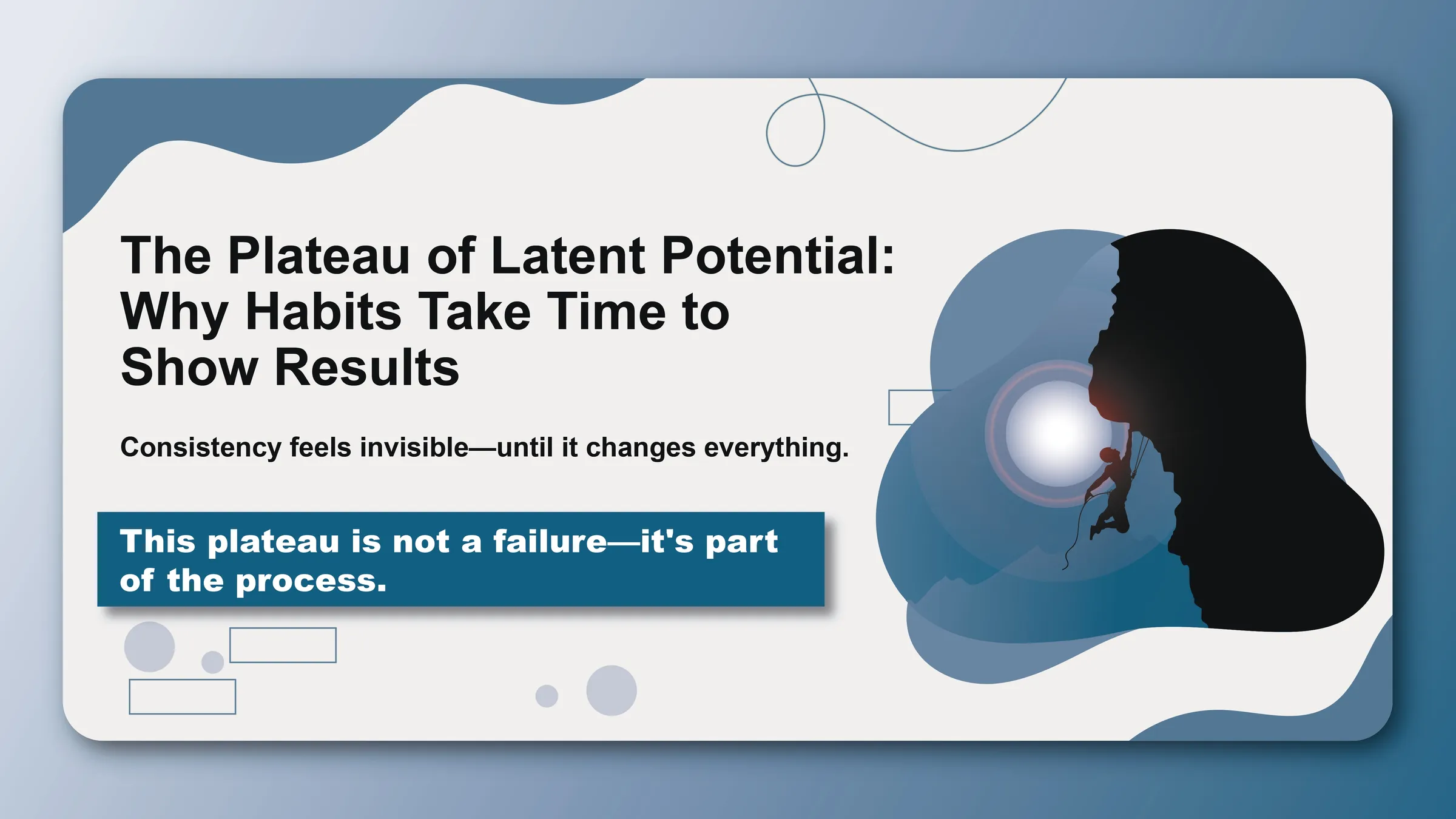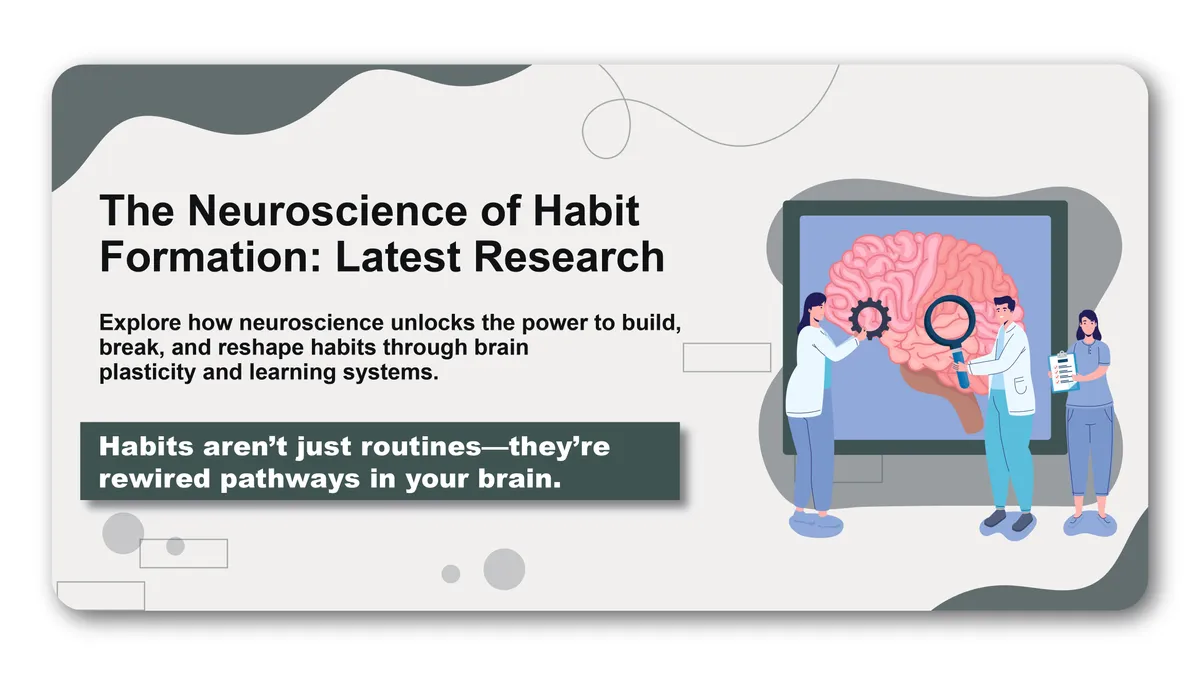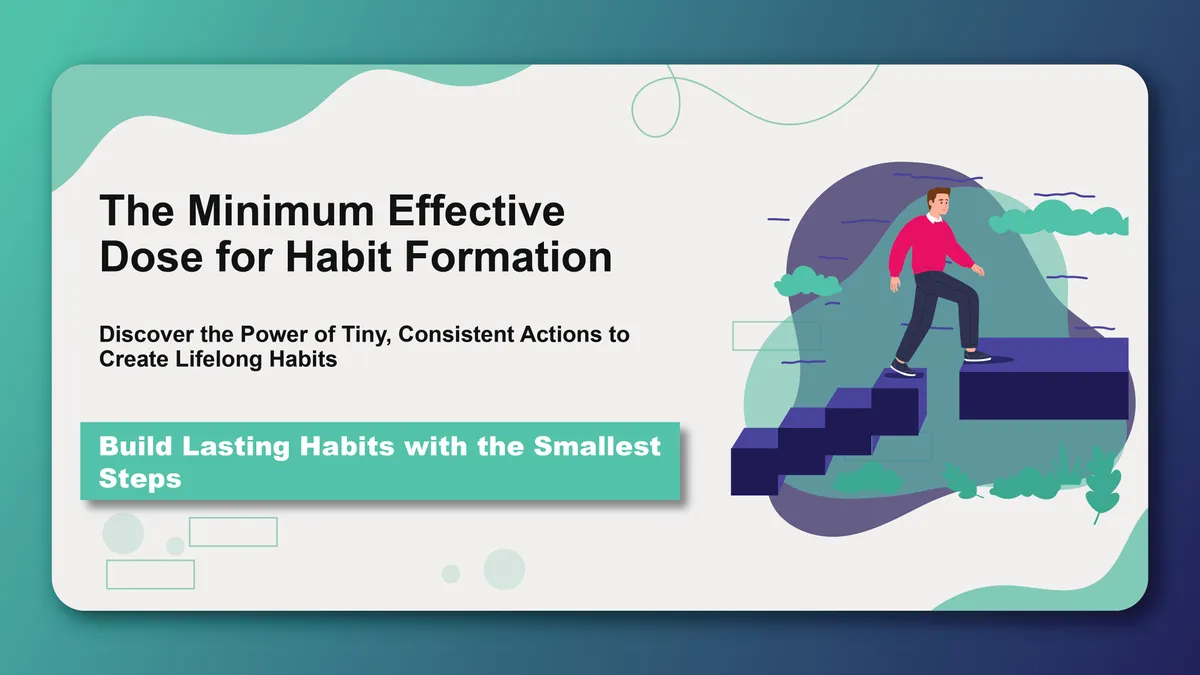You've been consistent for weeks. You've shown up every day, done the work, and followed the plan. But you don't see any meaningful results. You're tempted to quit, thinking the habit isn't working. Sound familiar?
Welcome to the Plateau of Latent Potential—the hidden valley where most people abandon their habits just before they would have transformed their lives. Understanding this concept is crucial for anyone serious about building lasting change.
What Is the Plateau of Latent Potential?
The Plateau of Latent Potential is the period between starting a habit and seeing noticeable results. It's the gap between input and output, effort and reward, consistency and transformation.
The Ice Cube Analogy
Imagine you're in a room that's 25 degrees. You heat it up one degree. Nothing happens. You heat it up another degree. Still nothing. You continue heating: 27, 28, 29, 30, 31 degrees. Nothing is happening. Then, at 32 degrees, the ice begins to melt.
The ice didn't melt because of the last degree of heat—it melted because of all the accumulated heat that came before. The same principle applies to habits.
The Habit Formation Timeline
Week 1-2: High motivation, minimal results Week 3-6: Motivation fades, still minimal visible results Week 7-12: The valley of disappointment—maximum frustration Week 13+: Breakthrough point—results become visible
Most people quit somewhere between week 3 and 12, right before they would have seen the transformation they were working toward.
The Science Behind Delayed Results
Neuroplasticity and Habit Formation
Your brain needs time to rewire itself. The process involves:
Neural Pathway Creation:
- Weeks 1-4: Initial pathways form but are weak
- Weeks 5-8: Pathways strengthen but compete with old patterns
- Weeks 9-12: New pathways become dominant
- Weeks 13+: Behaviors become automatic and effortless
The Compound Effect
Results don't accumulate linearly—they compound. This means:
Initial Period: 1 + 1 = 2 (linear results) Compound Period: 1 + 1 = 3, then 4, then 6, then 10 (exponential results)
The compound effect explains why habits feel ineffective initially but become transformative over time.
Different Habits, Different Timelines
Physical Habits:
- Visible results: 4-8 weeks
- Significant changes: 12-16 weeks
- Mastery: 6-12 months
Mental Habits:
- Initial awareness: 2-4 weeks
- Noticeable changes: 8-12 weeks
- Transformation: 6-18 months
Skill-Based Habits:
- Basic competence: 4-8 weeks
- Confident execution: 12-24 weeks
- Expertise: 1-3 years
Why the Plateau Exists
Evolutionary Programming
Your brain is wired to resist change because:
Energy Conservation: New behaviors require more energy than automatic ones Risk Aversion: Familiar patterns feel safer than new ones Homeostasis: Your brain prefers stable, predictable states Threat Detection: Changes are perceived as potential dangers
The Expectation Gap
What We Expect: Linear progress with immediate feedback What Actually Happens: Delayed, exponential progress with minimal early feedback
This gap creates frustration and leads to habit abandonment.
The Motivation Curve
Phase 1: High motivation, low competence Phase 2: Declining motivation, increasing competence Phase 3: Breakthrough - results become visible Phase 4: Renewed motivation, high competence
Most people quit during Phase 2, right before Phase 3.
The Valley of Disappointment
Characteristics of the Valley
Emotional Symptoms:
- Frustration with lack of progress
- Doubt about the habit's effectiveness
- Temptation to quit or try something else
- Feeling like effort is wasted
Behavioral Symptoms:
- Inconsistent practice
- Reduced effort or intensity
- Skipping days more frequently
- Looking for "better" alternatives
Mental Symptoms:
- Questioning the process
- Comparing to others who seem to progress faster
- Focusing on what's not working
- Catastrophic thinking about failure
The Quit Points
Week 3: Initial enthusiasm wears off Week 6: No visible progress despite consistency Week 10: Maximum frustration and doubt Week 12: Final decision point before breakthrough
Understanding these predictable quit points helps you prepare for them.
Strategies for Surviving the Plateau
1. Adjust Your Expectations
Realistic Timeline:
- Weeks 1-4: Focus on consistency, not results
- Weeks 5-8: Expect minimal visible progress
- Weeks 9-12: Prepare for maximum frustration
- Weeks 13+: Anticipate breakthrough
Mental Reframes:
- "I'm not behind, I'm in the valley"
- "This frustration is normal and temporary"
- "Every action is building toward my breakthrough"
- "I'm exactly where I should be in the process"
2. Track Process, Not Just Outcomes
Process Metrics:
- Days completed (consistency)
- Streak length (momentum)
- Effort level (engagement)
- Habit quality (improvement)
Leading Indicators:
- Reduced friction in starting
- Increased ease of execution
- Better habit quality
- Stronger identity connection
3. Create Intermediate Wins
Micro-Celebrations:
- Completing weekly goals
- Reaching streak milestones
- Improving habit quality
- Overcoming obstacles
Progress Markers:
- Weekly progress photos
- Skill assessments
- Energy level tracking
- Mood improvements
4. Build Anti-Fragility
Prepare for Setbacks:
- Plan for difficult days
- Create minimum viable habits
- Develop bounce-back strategies
- Build in flexibility
Strengthen Your Why:
- Connect habits to deeper values
- Visualize long-term outcomes
- Remember your initial motivation
- Focus on identity transformation
The Breakthrough Point
Signs You're Approaching Breakthrough
Behavioral Indicators:
- Habit feels more natural
- Less mental effort required
- Automatic execution in familiar contexts
- Discomfort when habit is missed
Psychological Indicators:
- Stronger identity connection
- Increased confidence
- Reduced resistance
- Intrinsic motivation emerges
Physical Indicators (for physical habits):
- Increased energy
- Improved sleep
- Better mood
- Noticeable physical changes
What Breakthrough Looks Like
Sudden Shift: Results become visible quickly Exponential Growth: Progress accelerates dramatically Effortless Execution: Habit becomes automatic Identity Alignment: "I am someone who does this"
Case Studies: Real Plateau Stories
Case Study 1: The Writer
Background: Sarah wanted to become a writer Habit: Write 500 words daily Plateau: Weeks 4-11, felt like nothing was improving Breakthrough: Week 12, completed first short story Result: Published author within 18 months
Key Lessons:
- Consistency during the plateau built skill
- Breakthrough came suddenly after months of "no progress"
- The plateau was building foundation for success
Case Study 2: The Fitness Enthusiast
Background: Mike wanted to get in shape Habit: 30-minute daily workouts Plateau: Weeks 3-10, no visible physical changes Breakthrough: Week 11, clothes started fitting better Result: Lost 40 pounds and transformed physique
Key Lessons:
- Internal changes preceded external ones
- Persistence through frustration was crucial
- Results accelerated after breakthrough
Case Study 3: The Meditator
Background: Lisa wanted to reduce stress Habit: 10-minute daily meditation Plateau: Weeks 2-14, felt like mind was still chaotic Breakthrough: Week 15, noticed significant calm Result: Transformed relationship with stress
Key Lessons:
- Mental habits take longer to show results
- Breakthrough was dramatic and transformative
- The plateau was necessary for neural rewiring
The Plateau in Different Life Areas
Health and Fitness
Plateau Length: 6-12 weeks Breakthrough Indicators: Energy, sleep, appearance Survival Strategy: Trust the process, focus on consistency
Learning and Skills
Plateau Length: 8-16 weeks Breakthrough Indicators: Confidence, competence, fluency Survival Strategy: Practice deliberately, celebrate small wins
Career and Professional Development
Plateau Length: 3-6 months Breakthrough Indicators: Recognition, opportunities, advancement Survival Strategy: Document progress, seek feedback
Relationships and Social Skills
Plateau Length: 2-4 months Breakthrough Indicators: Deeper connections, easier interactions Survival Strategy: Focus on consistency, not perfection
The Plateau Mindset
Embrace the Process
Process Over Outcome:
- Focus on daily actions, not distant results
- Celebrate consistency over performance
- Trust in compound effects
- Enjoy the journey, not just the destination
Develop Plateau Resilience
Mental Strategies:
- Normalize the plateau experience
- Prepare for emotional challenges
- Build support systems
- Practice self-compassion
Practical Strategies:
- Track leading indicators
- Create accountability systems
- Adjust habits based on feedback
- Maintain long-term perspective
The Post-Plateau Phase
Maintaining Momentum
After Breakthrough:
- Results become visible and motivating
- Habit feels more natural and effortless
- Identity shifts to support the behavior
- Motivation returns with visible progress
Avoiding Plateau Relapse
Common Mistakes:
- Becoming overconfident and inconsistent
- Dramatically increasing difficulty
- Focusing only on outcomes again
- Neglecting the systems that created success
Maintenance Strategies:
- Continue tracking consistency
- Gradually increase challenges
- Build in variation and novelty
- Remember the plateau lessons
Your Plateau Survival Plan
Phase 1: Preparation (Before Starting)
Set Realistic Expectations:
- Expect 8-16 weeks before visible results
- Prepare for emotional challenges
- Plan for consistency over perfection
- Focus on process metrics
Build Support Systems:
- Find accountability partners
- Join communities with similar goals
- Create environmental supports
- Develop self-compassion practices
Phase 2: Navigation (During the Plateau)
Week 1-4: Foundation Building
- Focus entirely on consistency
- Don't worry about results
- Celebrate showing up
- Adjust habit difficulty if needed
Week 5-8: Resistance Management
- Expect decreased motivation
- Rely on systems, not feelings
- Track process metrics
- Remind yourself of your why
Week 9-12: Persistence Testing
- Anticipate maximum frustration
- Focus on micro-improvements
- Practice self-compassion
- Lean on support systems
Week 13+: Breakthrough Preparation
- Watch for early breakthrough signs
- Maintain consistency despite progress
- Prepare for accelerated results
- Plan for post-plateau phase
Phase 3: Integration (After Breakthrough)
Consolidate Gains:
- Continue consistent practice
- Gradually increase difficulty
- Maintain tracking systems
- Share success with others
Prepare for Next Level:
- Identify next habit to build
- Apply plateau lessons learned
- Help others navigate their plateaus
- Celebrate transformation
The Power of Plateau Perspective
Understanding the Plateau of Latent Potential changes everything. It transforms frustration into patience, doubt into determination, and giving up into pushing through.
Remember: The plateau isn't a sign that your habit isn't working—it's a sign that it's working exactly as it should. Every day you persist through the valley of disappointment, you're building the foundation for breakthrough.
Your habits are like underground tree roots, growing strong and deep before the tree breaks through the surface. Trust the process, stay consistent, and prepare for the moment when all your hidden progress becomes visible.
The plateau is not your enemy—it's your teacher. It's teaching you patience, persistence, and the power of compound growth. Master the plateau, and you master the art of lasting change.
Ready to persist through your plateau and reach your breakthrough? Track your consistency with Habityzer and build the habits that will transform your life, one day at a time.



